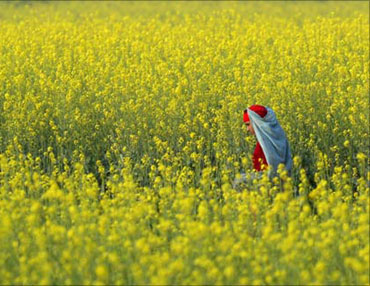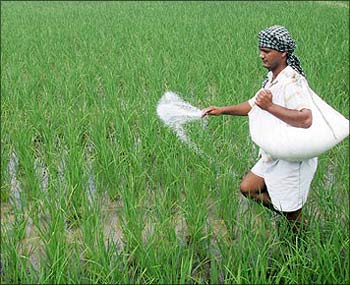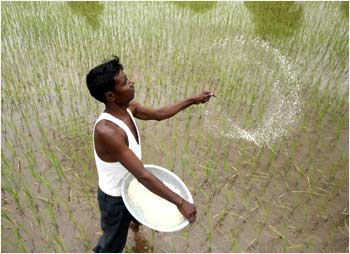
After failing to come anywhere near the 10th Five-Year Plan (2002-07) target of 4 per cent per annum rate of growth of agricultural output, the Planning Commission has projected a lower target growth rate of 3 to 3.5 per cent per annum for the 11th Plan period.
While some may view this as a more modest target, others may consider it as still far too ambitious, given the track record of the 10th Plan period, when the actual figure was around 2.3 per cent, with the comparable number for the decade 1995-2005 being 2 per cent.
What is, however, worrying is that this lower target rate of growth is, in fact, below the 3.62 per cent per annum growth rate recorded in the decade 1985-95. Moreover, given the anticipated overall GDP growth of over 8 per cent, the poor acceleration in the farm sector that still supports nearly 65 per cent of the population is an indictment of the strategy of 'inclusive growth'.
What these numbers tell is that the much-hyped 'second green revolution' is nowhere to be seen.
. . .

Several factors have combined to deliver this dismal result, ranging from inadequate investment in irrigation, research and development and in rural extension services to improper and often sub-optimal use of yield-enhancing inputs, including seeds, fertilisers, pesticides and, most importantly, water; poor technology transfer; and inefficient marketing that denies growers a fair share of what the consumer pays for farm goods.
Also contributing to it are factors like inadequate reach of institutional, timely and affordable, credit. All these factors constrain the farmers' ability to invest in farming.
Thus, while private investment is inadequate, public investment goes largely into 'subsidies', some of which, like in the case of water and power, are proving counterproductive by accelerating degradation of natural resources.
The Planning Commission had made it clear right in the beginning of the 11th Plan that hitting the target of 4 per cent annual agricultural growth would require the public investment to increase at a minimum of 12 per cent a year in real terms from its 2006-07 level. This seemed a truly tall order.
. . .

The first green revolution owed much to the spread of irrigation, which, in turn, spurred the use of other inputs, notably fertilisers. That is not happening any more.
For instance, most of the additional irrigation capacity created during the 10th Plan, only 50 per cent of the target on paper, was just notional because the land use data showed no increase in irrigated area.
This could be partly because the created potential was actually not utilised and partly because the old irrigated area steadily went out of the net due to poor maintenance or decay of the irrigation system.
Similarly, the use of fertilisers, the other key farm input that shows immediate results in terms of higher crop yields, is dismally low, besides being imbalanced.
. . .

The country's per-hectare consumption of fertiliser is estimated at merely around 113 kg, against 166 kg in the neighbouring Bangladesh and 137 kg in Pakistan.
Worse still, over half of the total fertiliser consumption is accounted for by five states -- Punjab, Maharashtra, Andhra Pradesh, Karnataka and Uttar Pradesh -- and virtually three crops (paddy, wheat and sugarcane).
Such a situation is far from conducive for the green revolution to spread out to more states and more crops.
Unless all such issues are addressed simultaneously, high and enduring agricultural growth may remain elusive. Both the Centre and states have to pay much closer attention to investment, productivity and institutional challenges in agriculture if the overall growth story has to remain hopeful.